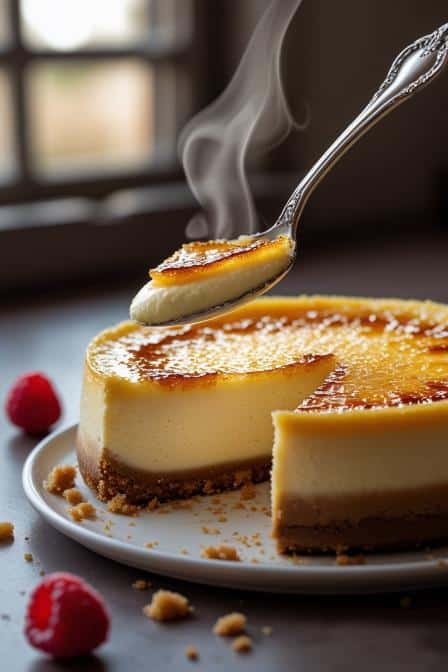Ever burned sugar with a spoon torch at 1 a.m., trying to recreate a restaurant dessert that lived rent-free in your tastebuds? I have. My fire alarm did not thank me, but oh, my tastebuds did. That first crack—spoon diving into the bronzed, glassy top of crème brûlée—it’s not just dessert, it’s drama. Now imagine that glory, married to a rich, velvety cheesecake. Not a knockoff. Not a mashup for clicks. This right here? It’s an indulgent hybrid that doesn’t just flirt with excellence—it marries it.
This is Crème Brûlée Cheesecake. It’s not fancy for the sake of fancy. It’s smart. Texturally complex. Soft like a silk pillow, crisp like early winter mornings. And it demands precision with just enough wiggle room for a rogue home baker to nail it like a pro.
Let’s dive into the why before the how.
What Makes Crème Brûlée Cheesecake So Special?
It’s the texture, innit? Traditional cheesecake is firm, but this one… it flirts with the edges of custard. Lighter, creamier, smoother. No dense, claggy mouthfeel. Then there’s the brûlée topping—scorched sugar with a sharp snap that collapses into caramel smoke and sweetness.
You don’t just eat it. You break into it.
This recipe hinges on a few critical techniques: slow baking, water bath, and careful torching. We’re fusing French custard culture with New York cheesecake swagger. Get ready.
Ingredients & Substitutions
Here’s what you’ll need to pull this off. But don’t fret—I’ll offer alternatives where they make sense. No gatekeeping here.
| Ingredient | Purpose | Substitutions & Notes |
|---|---|---|
| Graham cracker crumbs | Crust base | Digestive biscuits, crushed shortbread, or vanilla wafers |
| Unsalted butter | Binds crust | Salted butter (skip added salt), or ghee for nutty undertone |
| Cream cheese (full-fat) | Base of cheesecake | Neufchâtel for a slightly lighter version |
| Sour cream | Adds tang, softens texture | Greek yogurt (full-fat), or crème fraîche |
| Granulated sugar | Sweetens + caramelizes top | Coconut sugar for crust only; not for brûlée top |
| Egg yolks | Custard structure | No sub—yolks are non-negotiable here |
| Whole eggs | Structure and emulsification | Don’t use all yolks or all whites—balance matters |
| Vanilla bean or extract | Flavor depth | Paste works great; avoid imitation vanilla |
| Heavy cream | Luxurious mouthfeel | Double cream in the UK; don’t sub with milk |
| Salt | Balances sweetness | Just a pinch—omit if using salted butter |
Pro Tip: Use room temp ingredients. Cold eggs or cream cheese = lumpy batter = weeping cheesecake = sadness.
Step-by-Step Instructions
Let’s not lose the plot here—each step matters. It’s dessert alchemy. And slightly chaotic fun.
1. Prepare the Crust
- Mix 1 ½ cups graham crumbs with 5 tbsp melted butter and a pinch of salt.
- Press into a 9-inch springform pan. Up the sides, too—about halfway.
- Bake at 170°C (340°F) for 10 mins. Let cool.
Mistake to avoid: Don’t skip pre-baking. No one wants soggy-bottom cheesecake.
2. Make the Cheesecake Filling
- Beat 680g cream cheese till smooth. No lumps. Scrape down those sides—do it.
- Add 1 cup sugar slowly. Mix on low. Air bubbles = cracking.
- Blend in 1 tsp vanilla and ½ tsp salt.
- Beat in 3 whole eggs, one at a time.
- Add 2 egg yolks. Mix till just combined.
- Stir in ½ cup sour cream + ½ cup heavy cream.
Texture trick: Mix slowly. This isn’t a whipped cream situation. Overmix = soufflé. And you don’t want soufflé.
3. Water Bath Setup
- Wrap bottom of springform pan in heavy-duty foil. Waterproof it.
- Set in a deep roasting pan.
- Pour hot water halfway up the sides.
Why this matters: The bain-marie (water bath) gently coaxes the cheesecake into creamy submission without cracking or curdling.
4. Bake It
- Bake at 150°C (300°F) for about 65–75 mins. Center should jiggle slightly.
- Turn oven off. Let it sit inside for another hour, door ajar.
Common mistake: Opening oven while baking = temp drop = cracks = bad day.
5. Chill & Brûlée
- Chill at least 6 hours, ideally overnight.
- Just before serving, sprinkle a thin layer of granulated sugar (2–3 tbsp).
- Torch it until golden, blistered, and glassy.
No torch? Broiler on high works—place cheesecake close to heat for 2–3 mins. But watch it like a hawk with a coffee addiction.
Cooking Techniques & Science Behind the Magic
Let’s unpack why this works. There’s science. Lots of it.
Cream Cheese Emulsion: Full-fat cream cheese holds water and fat together in a stable emulsion. Beat it too hard? That structure breaks, and your cake leaks like a busted pipe.
Water Bath Physics: That moist environment evens out heat distribution. It prevents the outside from overcooking while the middle is still setting. Dry heat cracks the top like desert soil.
Egg Yolks vs. Whole Eggs: Yolks thicken gently, contributing to that custardy mouthfeel. Whites add structure but can over-firm if overbaked. That’s why we blend both—balance.
Brûlée Layer Chemistry: The sugar melts at 160°C (320°F) and caramelizes between 170–180°C (338–356°F). Go past that? It burns bitter. The crust forms due to Maillard reaction—browning of sugars and amino acids.
Storage & Reheating
- Store in the fridge, covered, for up to 4–5 days.
- Don’t brûlée in advance—topping goes soft.
- You can freeze it, minus topping. Wrap tight, defrost overnight.
- Reheating? Nah. Eat it cold or room temp. Cheesecake doesn’t like the microwave.
Variations & Substitutions
- Mini Cheesecakes: Use muffin tins with liners. Bake ~20–25 mins.
- Lemon Brûlée Cheesecake: Add 1 tbsp lemon zest + 2 tbsp juice. Skip vanilla.
- Chocolate Swirl: Melted dark chocolate ribboned through before baking.
- Gluten-Free: Use almond flour + melted butter for the crust.
- Vegan: Not gonna lie, this is tricky. Try cashew cream + coconut milk + agar instead of eggs. But brûlée topping might not behave the same.
Tools You Really Do Need
- Springform pan. Non-negotiable. Regular pans? Good luck unmolding that mess.
- Torch. Unless you like pain (and broilers).
- Mixer (hand or stand). No one wants to beat cream cheese by hand. Trust me.
- Roasting pan. Deep enough for water bath.
Serving & Pairing Suggestions
Serve it cold, but not straight-out-the-fridge cold. Let it sit for 15–20 mins. The flavors bloom as it warms a touch.
Plating? White plate, dust of powdered sugar on the side, maybe a berry or three. Keep it minimal. Let that caramel shine like a glass crown.
Pairings:
- Drink: Late harvest Riesling or Sauternes. You want sweet with acid.
- Side: Fresh raspberries or passionfruit pulp. Their tartness pops against the rich base.
- Texture pop: Candied pistachios or almond brittle shards.
Best Time to Eat It?
Late night. After dinner. Or alone on the couch when everyone’s asleep. Honestly, there’s no bad time.
But it hits different when the house is quiet, the spoon cracks through the sugar, and you have a moment of complete stillness before flavor chaos.
Conclusion: Why This Recipe Matters
Crème Brûlée Cheesecake is more than a dessert—it’s technique and nostalgia in every bite. A dish that demands care but rewards you with sheer elegance.
It teaches patience. It teaches restraint. It’s a sensory experience—the smell of torched sugar, the snap of crust, the melt of custard-soft cheese filling.
Don’t rush the process. Don’t skimp on the cream. Trust the science. And remember—good things come to those who water bath.
If you mess it up? No worries. You’ve got a base cheesecake. Spoon it straight from the pan like the savage sweet tooth that lives in all of us.
FAQs
1. Why did my cheesecake crack even with a water bath?
You may have overmixed the batter or opened the oven too early. Next time, mix on low speed and let the cake rest in the oven after baking.
2. Can I brûlée the sugar in advance?
Nope. It will soften and lose its crunch. Always brûlée just before serving.
3. My sugar didn’t melt evenly. What’s wrong?
Either your sugar layer was too thick, or your torch/broiler wasn’t hot enough. Try superfine sugar next time for even caramelization.
4. Can I make it without a springform pan?
Technically, yes. But unmolding is tricky and messy. A springform makes your life easier and your cake prettier.
5. How do I know it’s baked enough?
The edges should look set, and the center should have a slight wobble. Overbake it and it’ll be dry; underbake and it’ll be soupy. Trust the jiggle.
Let the spoon crack the surface. Let your fork dive into that custard pillow. And let this recipe earn a permanent spot in your greatest hits.

